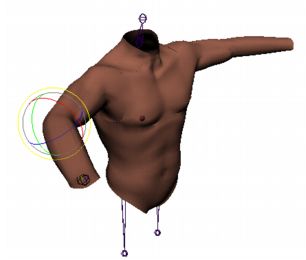
SKELETONS AND SKINNING

What are SKELETONS?
Skeletons are hierarchical, articulated structures that let you pose and animate bound models. A skeleton provides a deformable model with the same underlying structure as the human skeleton gives the human body.
Just like in the human body, the location of joints and the number of joints you add to a skeleton determine how the skeleton's bound model or `body' moves. When you bind a model to a skeleton, it is called skinning. For more information on the process of skinning, see the What is skinning?.
What is SKINNING ?
Skinning or binding is the process of setting up a character's model so that it can be deformed by a skeleton. For more information on skeletons, see What are skeletons?. You skin a model by binding a skeleton to the model. You can bind a model to a skeleton by a variety of skinning methods, including smooth skinning and rigid skinning. Smooth skinning and rigid skinning are direct skinning methods. You can also use indirect skinning methods, which combine the use of lattice or wrap deformers with either smooth or rigid skinning.
skinning (binding) methods
The direct skinning methods include rigid and smooth skinning.
Rigid skinning

Rigid skinning provides articulated deformation effects by enabling joints to influence sets of deformable object points. The points of rigid-bound skin have a weight either 100% joint-membership, or 0%. (they can be thought of as binary appointments to joints). Because of this simplicty, Rigid-binding in cheap to calculate, but can leave tear between two opposing rotating joints, such as in arms or knees.
Smooth skinning

Smooth skinning provides smooth, articulated deformation effects by enabling several joints to influence the same deformable object points (CVS, vertices, or lattice points). Since serveral joints may influence common points or clusters, they influence is very sublte and combined.. So, any point may have a combo of influences, percentage divided between two or more joints. Smooth bound surface are calculative and more expensive and simpler (binary) rigid-bound appointments.